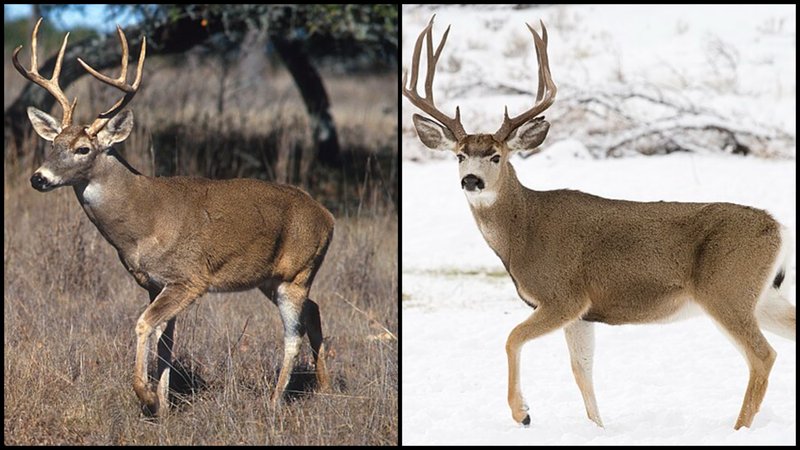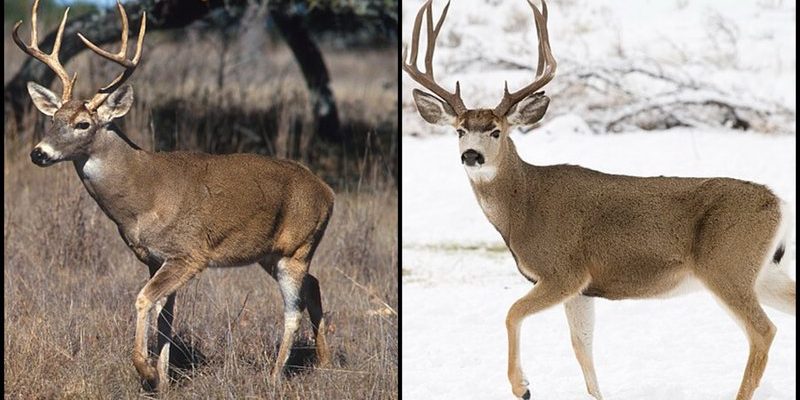
Just as each family member has their own quirks, so too do the animals that resemble mule deer. Understanding how to differentiate them can be as enlightening as scrolling through your family tree. In this article, we’ll dive into 10 animals that share similarities with mule deer and explore how to tell them apart. Whether you’re a wildlife enthusiast or just curious about the creatures roaming our forests, this guide is designed for you!
Mule Deer: A Quick Overview
Before we jump into the look-alikes, let’s quickly recap what makes the mule deer special. These animals are typically found in the western United States and parts of Canada and Mexico. They have large, spoon-shaped ears, which help them hear predators sneaking around. Their coats change color with the seasons—brownish in summer and grayish in winter—making them a bit of a chameleon.
Mule deer are known for their unique behavior when alarmed. Instead of running away, they often freeze in place, blending into their surroundings, which can be surprising if you’re trying to spot one in the wild. Their distinctive features and behaviors set them apart, but this doesn’t mean they’re the only players in this game of deer-like animals. Let’s explore some of their close relatives.
1. White-tailed Deer
If you’re in North America, the white-tailed deer is often the first cousin to the mule deer. With its characteristic white underside to its tail, this deer is unmistakable. When threatened, it raises its tail, revealing that white patch as a warning signal to other deer.
You might also notice these deer are smaller than mule deer, typically weighing between 100 to 300 pounds. Their antlers are different too—white-tailed deer have a single main beam that often forks, while mule deer’s antlers are more branched.
When spotting them, pay attention to their behavior. White-tailed deer tend to be more skittish and are quick to bolt at the slightest noise, unlike the more laid-back mule deer.
2. Black-tailed Deer
The black-tailed deer, found mainly along the west coast, especially in areas like California and Oregon, is another close relative. They look similar to mule deer but have darker fur, particularly around their tails, giving them that distinctive “black-tailed” name.
One key difference is their habitat preference—black-tailed deer are more accustomed to dense forests and coastal scrub, while mule deer prefer open fields and mountainous regions. If you find yourself hiking the Pacific coast, keep an eye out for this subtle beauty!
3. Fallow Deer
Next up is the fallow deer, often seen in parks and reserves. While they have a similar body shape to mule deer, fallow deer have a more varied coat, typically featuring spots, which gives them a unique appearance.
Their antlers also differ significantly; they’re broad and flat compared to the branching antlers of mule deer. If you spot a deer with beautiful spotted fur, you’re likely looking at a fallow deer, not a mule deer!
4. Axis Deer
The axis deer, or chital, is a stunning animal with a unique blend of color and markings. They hail from India and possess striking spots on their coat, reminiscent of a fallow deer but with a more refined elegance.
These deer are larger than mule deer and have a more slender build. The key thing to note is their behavior; axis deer are social and often found in herds, unlike the more solitary mule deer. If you see a group of deer with a strong sense of community, you might just be observing axis deer.
5. Red Deer
Moving to Europe, we find the red deer. They’re significantly larger than mule deer, often weighing over 700 pounds! With their impressive antlers that can grow to be quite majestic, red deer stand out in any crowd.
Their fur is a reddish-brown—especially during the summer—which is a notable contrast to the mule deer’s more grayish-brown coat. If you spot a particularly large deer with towering antlers grazing in the distance, it’s likely a red deer rather than a mule deer.
6. Sika Deer
Sika deer are small, stocky deer native to East Asia. They have a more compact build and are covered in white spots throughout their dark brown coats, making them visually distinct from mule deer.
If you see a deer that seems to blend into its surroundings with its short legs and stocky body, it could very well be a sika. Their vocalizations are also quite different; sika deer are known for their barking sounds, which can give them away in dense foliage.
7. Reindeer
You might think of reindeer as magical creatures from holiday tales, but they share several traits with mule deer. Found in Arctic and Subarctic regions, reindeer have larger bodies and thicker coats to cope with the cold.
Their antlers are also unique; unlike mule deer, both male and female reindeer grow antlers. If you see a large deer with impressive antlers and a stocky build in a snowy landscape, you might just be looking at a reindeer instead of a mule deer.
8. Iberian Red Deer
The Iberian red deer is a subspecies of the red deer found in Spain and Portugal. They’re slightly smaller than their northern cousins but still bulkier than mule deer. Their coloration is also more vibrant, often featuring a deep reddish hue.
You’ll also notice differences in their social behavior; Iberian red deer typically live in larger groups than mule deer. If you’re in the Mediterranean, take a close look at any deer you see around—you might spot one of these!
9. Moose
Moose are giants compared to mule deer, standing at up to 6.5 feet tall! While they have a different body shape and disproportionately long legs, their habitats can overlap in certain regions, making them a possible point of confusion.
Unlike mule deer, which have a more delicate frame, moose have a more robust body with a distinctive hump on their back. If you see a large, shaggy creature munching on tree branches, it’s surely a moose and definitely not a mule deer.
10. Elk
Lastly, let’s talk about elk. Often larger than mule deer, elk can weigh up to 1,100 pounds! They have large, impressive antlers similar to red deer but usually longer.
One of the biggest differences is their vocalization; elk are known for their loud bugling calls during mating season, a sound you won’t hear from mule deer. If you spot a large deer with a commanding presence in a meadow, it’s likely an elk, not a mule deer.
Wrapping It Up
So there you have it—ten animals that are similar to mule deer, each with their own unique traits. Whether you’re hiking through forests or just enjoying a stroll in nature, it’s fascinating to pay attention to the differences among these deer. By knowing what to look for, you can become a more informed wildlife observer and appreciate the rich diversity of our natural world. Happy spotting!

